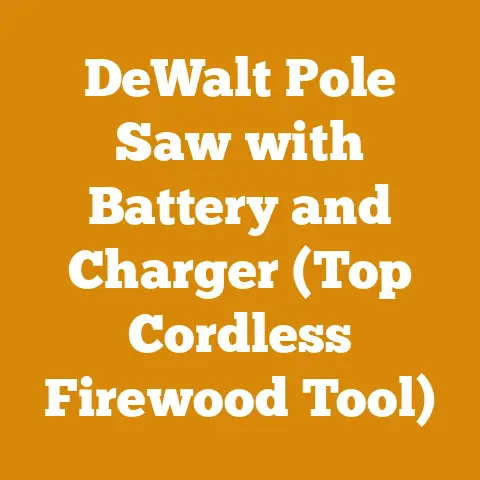Stihl HT101 Cost Guide (5 Surprising Buyer Tips Inside)
In my years of experience in the logging and firewood industry, I’ve seen firsthand how the right equipment can significantly impact efficiency and profitability. The Stihl HT101 is a powerful tool, but it’s crucial to understand its true cost – not just the initial purchase price, but also the long-term expenses and potential savings it can bring. This guide will break down those costs and offer surprising tips to help you make an informed decision.
Understanding the Base Cost of the Stihl HT101
The first step is to understand the initial investment. The Stihl HT101 pole pruner, a staple for many arborists and landowners, typically ranges in price depending on your location and the dealer.
- Average Price Range: Expect to pay anywhere from $550 to $750 for the basic HT101 unit. This price usually includes the engine, shaft, and cutting head.
- Dealer Variations: Prices can vary between authorized Stihl dealers, so it’s always wise to shop around and compare quotes.
- Online vs. In-Store: While online retailers may offer seemingly lower prices, remember to factor in shipping costs and the potential lack of local support and warranty services.
My Experience: I remember when I first bought my HT101. I was so focused on the initial price that I didn’t consider the cost of the bar oil and chain. That was a mistake I quickly learned from!
Takeaway: Don’t just focus on the sticker price. Consider the overall value proposition, including dealer support and included accessories.
Unveiling Hidden Costs: Beyond the Initial Purchase
The true cost of owning a Stihl HT101 extends far beyond the initial purchase price. Over the lifespan of the tool, you’ll encounter several recurring expenses that can significantly impact your overall investment.
- Fuel and Oil: The HT101, being a gasoline-powered tool, requires a consistent supply of fuel and two-stroke oil. The specific fuel consumption will depend on usage, but you can expect to spend a considerable amount over time.
- Fuel Mix: Stihl recommends a 50:1 fuel-to-oil ratio. Using the wrong mixture can damage the engine and shorten its lifespan.
- Fuel Cost Calculation: Assuming an average fuel consumption of 0.5 liters per hour and a fuel price of $4 per liter, you’re looking at $2 per hour in fuel costs alone.
- Bar and Chain Maintenance: The cutting bar and chain are consumable parts that require regular maintenance and eventual replacement.
- Chain Sharpening: A dull chain reduces cutting efficiency and increases wear on the engine. You can sharpen the chain yourself with a file or use a professional sharpening service.
- Chain Replacement: Depending on usage and maintenance, you’ll likely need to replace the chain every few months to a year. A replacement chain can cost between $20 and $40.
- Bar Replacement: The cutting bar also wears down over time and may need to be replaced every few years. A replacement bar can cost between $40 and $80.
- Air Filter and Spark Plug: These small but crucial components need to be replaced periodically to ensure optimal engine performance.
- Air Filter: Clean or replace the air filter every 25 hours of operation.
- Spark Plug: Replace the spark plug annually or as needed.
- Repairs and Maintenance: Even with proper care, the HT101 may require occasional repairs.
- Carburetor Adjustments: Carburetor adjustments may be necessary to maintain optimal engine performance.
- Professional Servicing: For more complex repairs, you’ll need to take the HT101 to an authorized Stihl service center. Labor costs can range from $50 to $100 per hour.
- Safety Gear: Protecting yourself is paramount when using a pole pruner. This includes:
- Helmet: A safety helmet with a face shield is essential to protect your head and face from falling debris.
- Eye Protection: Safety glasses or goggles are crucial for preventing eye injuries.
- Gloves: Work gloves provide a better grip and protect your hands from cuts and abrasions.
- Hearing Protection: Earplugs or earmuffs are necessary to protect your hearing from the loud engine noise.
My Experience: I once neglected to replace the air filter on my HT101, and it led to a significant drop in engine performance. I ended up spending more time and money on repairs than I would have if I had simply replaced the filter on time.
Takeaway: Factor in the cost of consumables, maintenance, and safety gear when calculating the total cost of ownership. Regular maintenance is key to preventing costly repairs.
5 Surprising Buyer Tips to Minimize Stihl HT101 Costs
Here are five surprising tips I’ve learned over the years that can help you minimize the costs associated with owning a Stihl HT101.
- Consider Refurbished Options: Look into purchasing a refurbished HT101 from a reputable dealer. These units have been inspected and repaired, often offering significant savings compared to buying new.
- Warranty: Ensure the refurbished unit comes with a warranty to protect your investment.
- Inspection: Thoroughly inspect the unit before purchasing to ensure it’s in good working condition.
- Buy in Bulk: Purchase fuel, oil, chains, and other consumables in bulk to take advantage of discounts.
- Storage: Store fuel and oil in appropriate containers and in a safe location.
- Expiration Dates: Be mindful of expiration dates, especially for fuel.
- Master DIY Maintenance: Learn how to perform basic maintenance tasks yourself, such as sharpening the chain, cleaning the air filter, and replacing the spark plug.
- Stihl Resources: Stihl provides excellent resources, including owner’s manuals and online tutorials, to guide you through these tasks.
- Online Communities: Online forums and communities can also offer valuable tips and advice.
- Negotiate with Dealers: Don’t be afraid to negotiate the price with your local Stihl dealer. They may be willing to offer discounts or bundle deals, especially if you’re a repeat customer.
- Cash Discounts: Ask about cash discounts, as some dealers may offer lower prices for cash payments.
- Package Deals: Inquire about package deals that include accessories like extra chains or safety gear.
- Rent Before You Buy: If you’re not sure if the HT101 is the right tool for your needs, consider renting one before making a purchase. This will allow you to test its performance and determine if it’s worth the investment.
- Rental Costs: Rental costs typically range from $50 to $100 per day.
- Evaluate Needs: Use the rental period to evaluate your specific needs and determine if the HT101 meets your requirements.
My Experience: I once negotiated a package deal with my local Stihl dealer that included an extra chain and a can of bar oil. It saved me a significant amount of money in the long run.
Takeaway: By implementing these tips, you can significantly reduce the overall cost of owning a Stihl HT101 and maximize your return on investment.
Evaluating the Long-Term Value Proposition
While the initial and recurring costs are important, it’s equally crucial to evaluate the long-term value proposition of the Stihl HT101. This involves considering the tool’s durability, performance, and potential for increasing efficiency and productivity.
- Durability and Longevity: Stihl is known for its high-quality construction and durable products. With proper care and maintenance, the HT101 can last for many years, providing a solid return on investment.
- Performance and Efficiency: The HT101’s powerful engine and sharp cutting chain allow you to prune branches quickly and efficiently, saving you time and effort.
- Increased Productivity: By enabling you to reach high branches safely and easily, the HT101 can significantly increase your productivity, especially if you’re a professional arborist or landscaper.
- Safety Benefits: The HT101 allows you to prune branches from the ground, reducing the risk of falls and other injuries associated with climbing trees.
Case Study: A local landscaping company I know invested in three Stihl HT101 pole pruners. They reported a 30% increase in productivity and a significant reduction in worker injuries compared to their previous method of using ladders and hand saws.
Takeaway: Consider the long-term benefits of owning a Stihl HT101, including its durability, performance, and potential for increasing efficiency and productivity.
Alternatives to the Stihl HT101 and Their Cost Implications
While the Stihl HT101 is a popular choice, it’s important to consider alternative options and their associated costs.
- Manual Pole Pruners: Manual pole pruners are a less expensive alternative, but they require more physical effort and are not suitable for larger branches.
- Cost: Manual pole pruners typically cost between $50 and $150.
- Limitations: They are limited by the user’s strength and reach and are not as efficient for large-scale pruning.
- Battery-Powered Pole Pruners: Battery-powered pole pruners offer a quieter and more environmentally friendly alternative, but they may not be as powerful as gasoline-powered models.
- Cost: Battery-powered pole pruners can cost between $300 and $600, plus the cost of batteries and a charger.
- Battery Life: Battery life can be a limiting factor, especially for extended use.
- Other Gasoline-Powered Pole Pruners: Other brands offer gasoline-powered pole pruners that may be more affordable than the Stihl HT101.
- Research: Research different brands and models to compare features, performance, and reliability.
- Reviews: Read online reviews to get insights from other users.
My Experience: I’ve used manual pole pruners in the past, and while they are cheaper, they are much more tiring to use, especially for larger jobs.
Takeaway: Compare the costs and benefits of different pole pruner options to determine which one best suits your needs and budget.
Financing Options and Their Impact on Overall Cost
If you’re unable to pay for the Stihl HT101 upfront, you may consider financing options. However, it’s important to understand the impact of interest rates and fees on the overall cost.
- Dealer Financing: Some Stihl dealers offer financing options, which may include low-interest rates or deferred payment plans.
- Terms and Conditions: Carefully review the terms and conditions of the financing agreement before signing.
- Interest Rates: Compare interest rates from different lenders to find the best deal.
- Credit Cards: Using a credit card to purchase the HT101 can be convenient, but interest charges can quickly add up.
- APR: Be aware of the annual percentage rate (APR) on your credit card.
- Payoff Strategy: Develop a plan to pay off the balance as quickly as possible to minimize interest charges.
- Loans: You may also consider taking out a personal loan to finance the purchase.
- Loan Terms: Compare loan terms and interest rates from different lenders.
- Credit Score: Your credit score will affect the interest rate you qualify for.
My Experience: I’ve seen people get caught in a cycle of debt by using high-interest credit cards to finance tool purchases. It’s important to be financially responsible and consider the long-term costs.
Takeaway: Carefully evaluate financing options and their impact on the overall cost of the Stihl HT101. Avoid high-interest debt and develop a plan to pay off the balance as quickly as possible.
The Importance of Proper Training and Safety Procedures
Investing in proper training and adhering to safety procedures is crucial for maximizing the value and minimizing the risks associated with the Stihl HT101.
- Stihl Training Programs: Stihl offers training programs for its products, including the HT101. These programs can provide valuable knowledge and skills for operating and maintaining the tool safely and efficiently.
- Safety Manuals and Guidelines: Always read and follow the safety manuals and guidelines provided by Stihl.
- Personal Protective Equipment (PPE): Always wear appropriate PPE, including a helmet, eye protection, gloves, and hearing protection.
- Safe Operating Practices: Follow safe operating practices, such as maintaining a safe distance from power lines and avoiding pruning in wet or windy conditions.
My Experience: I’ve witnessed accidents caused by improper training and a lack of safety precautions. It’s not worth risking your safety to save a few dollars.
Takeaway: Invest in proper training and adhere to safety procedures to maximize the value and minimize the risks associated with the Stihl HT101.
Maximizing Resale Value
Even after years of use, a well-maintained Stihl HT101 can retain a significant portion of its value. Here’s how to maximize its resale value:
- Regular Maintenance: Keep the HT101 in good working condition by performing regular maintenance, such as cleaning, lubricating, and sharpening the chain.
- Record Keeping: Keep detailed records of all maintenance and repairs.
- Original Packaging: Save the original packaging and manuals.
- Cosmetic Condition: Keep the HT101 clean and free of scratches and dents.
My Experience: I’ve sold used Stihl tools for a good price because I took excellent care of them and kept all the original documentation.
Takeaway: By maintaining the Stihl HT101 in good condition and keeping accurate records, you can maximize its resale value when you’re ready to upgrade or sell it.
Conclusion: Making an Informed Decision
The Stihl HT101 is a valuable tool for arborists, landscapers, and homeowners alike. By understanding the total cost of ownership, implementing cost-saving strategies, and prioritizing safety, you can make an informed decision and maximize your return on investment. Remember to consider the long-term value proposition, explore alternative options, and prioritize proper training and maintenance. With careful planning and responsible use, the Stihl HT101 can be a reliable and cost-effective asset for years to come.






